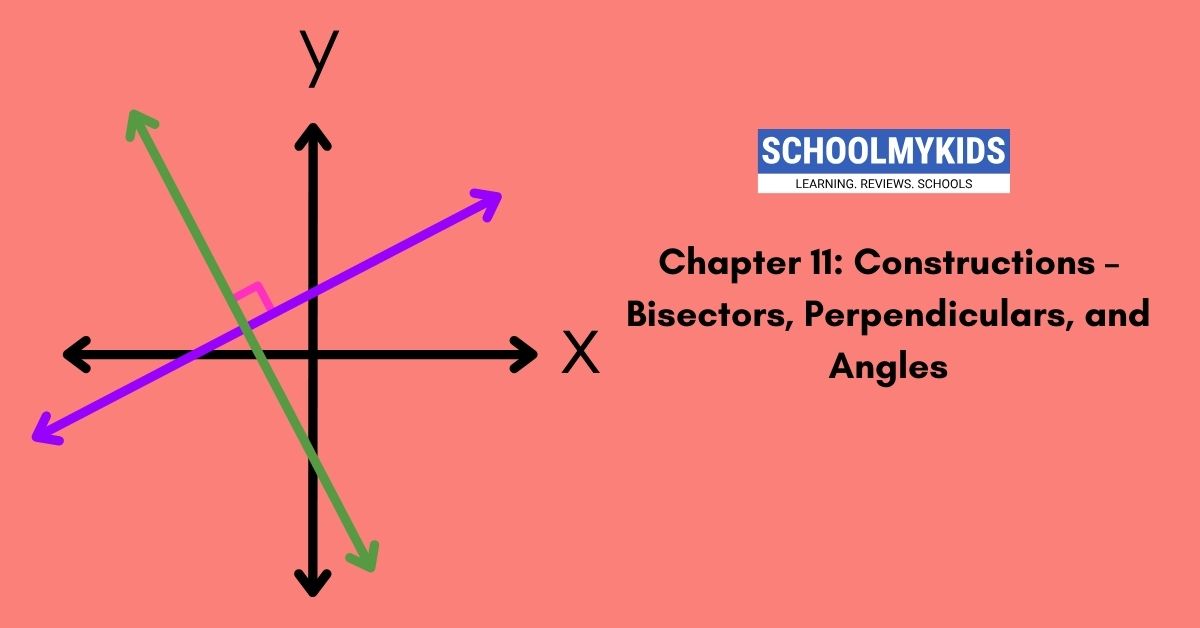This chapter dives into the world of constructions, focusing on using a compass and straightedge to create specific geometrical elements. Here, we’ll explore constructing bisectors (of angles and line segments), perpendicular lines, and angles of specific measures. This chapter is no longer part of class 10 Maths syllabus.
Important Note: No formulas are involved in constructions; they rely on geometric principles and following specific steps with compass and straightedge.
1. Constructing the Bisector of an Angle
A bisector divides an angle into two equal parts.
Steps:
- Draw the angle you want to bisect (∠ABC).
- Place the compass point at the vertex (point B).
- Set the compass opening to any convenient width.
- With that width, draw two arcs, one intersecting each ray of the angle (one arc inside each angle sector).
- Without changing the compass width, place the compass point at one of the intersection points (say, point P on AB).
- Draw another arc that intersects the other ray of the angle (on AC).
- Mark the point where this new arc intersects AC (point Q).
- Line segment BPQ is the angle bisector of ∠ABC.
Explanation:
- The chosen compass width ensures both arcs (from step 4) cut across both sides of the angle.
- Steps 5 and 6 ensure both new arcs (with the same compass width) cut each ray of the angle once.
- Line segment BPQ divides ∠ABC into two congruent angles (∠ABP and ∠PBQ) because the arcs created in steps 4 and 6 are equal in radius.
2. Constructing the Perpendicular Bisector of a Line Segment
The perpendicular bisector of a line segment is a line that passes through the midpoint of the segment and is perpendicular to it.
Steps:
- Draw the line segment you want to find the perpendicular bisector for (say, line segment AB).
- Set the compass width wider than half the length of the line segment (AB).
- Place the compass point at one endpoint (A) and draw an arc above and below the line segment that intersects the other endpoint (B).
- Repeat step 3, placing the compass point at endpoint B and ensuring the same compass width is used.
- The two arcs will intersect at two points (say, points P and Q) above the line segment.
- Draw line PQ. Line PQ is the perpendicular bisector of line segment AB.
Explanation:
- The compass width chosen in step 2 ensures both arcs will intersect each other above the line segment.
- Since the compass width is the same in both placements (A and B), the radii of the arcs will be equal.
- The two intersection points (P and Q) are equidistant from both A and B (due to equal radii), making PQ the perpendicular bisector that passes through the midpoint of line segment AB.
3. Constructing an Angle of a Specific Measure (Using a Protractor)
While a compass and straightedge can’t directly construct angles of specific measures, you can use a protractor to achieve this.
Steps:
- Draw a ray (say, ray BC).
- Place the center of the protractor at point B (the endpoint of the ray).
- Align the protractor’s base line with ray BC.
- Locate the desired angle measure on the protractor’s scale.
- Mark a point (say, point A) on ray BC corresponding to the chosen angle measure.
- Line segment BA represents the angle with the desired measure (∠ABC).
Note: This method relies on a physical protractor to measure and transfer the angle measure.
More Advanced Techniques
This section explores some additional constructions that build upon the basic principles introduced earlier.
1. Constructing the Angle Bisector of a Triangle
There are two common methods for this construction:
- Using the Perpendicular Bisector of the Base:
- Construct the perpendicular bisector of the base of the triangle (say, line segment BC in triangle ABC). The intersection point of this bisector with the opposite side (AC) will be the angle bisector of angle A (point D).
- Using Intersecting Incircles (requires prior knowledge of inscribed circles):
- Construct the incircle (tangent to all three sides) of the triangle.
- Draw lines from each vertex (A, B, and C) to the point of tangency on the corresponding side.
- The intersection point of these two lines (excluding the base) will be the angle bisector (point D).
2. Constructing a Line Perpendicular to a Line at a Point
- Method 1 (Using the Bisector of an Angle):
- Draw the line (say, line AB) and mark the point (point P) where you want the perpendicular line to intersect.
- Place the compass point at point P and set a convenient width.
- Draw two arcs intersecting line AB on either side of point P.
- Without changing the compass width, place the compass point at one of the intersection points (say, point Q) and draw an arc above line AB.
- Repeat step 4 from the other intersection point (say, point R).
- The two new arcs will intersect above line AB (point S).
- Draw line PS. Line PS is perpendicular to line AB at point P.
- Method 2 (Using Two Bisectors):
- Similar to method 1, draw two intersecting arcs from point P on line AB.
- Draw lines through point P bisecting the angles formed by the arcs and line AB.
- The intersection point of these two bisecting lines will be point S, and line PS is perpendicular to line AB at point P.
3. Constructing a Parallel Line
- Method 1 (Using Corresponding Angles):
- Draw the line (say, line AB) and mark a point (point P) not on the line.
- Draw a ray (say, ray PQ) emanating from point P and intersecting line AB at point Q.
- Choose a convenient angle measure (e.g., 45°) and use your protractor to construct a line through point P that makes an angle with ray PQ equal to the chosen measure on the same side as line AB.
- This newly constructed line will be parallel to line AB.
- Method 2 (Using Transversal Angles):
- Similar to method 1, draw a line (AB) and a ray (PQ) intersecting it at point Q.
- Draw another line (say, line RS) intersecting both line AB (at point S) and ray PQ (at point R).
- As long as lines AB and RS are not parallel, corresponding angles (alternate interior or same-side interior) will be congruent.
- Use a protractor to copy the measure of one of these corresponding angles (say, ∠QRS) next to line AB, creating a line through point P that makes an angle with ray PQ congruent to ∠QRS.
- This newly constructed line will be parallel to line AB.
These are just a few examples of more intricate constructions. Remember, these techniques rely on a combination of the basic constructions from the previous section and might involve using a protractor for specific angle measurements. As you progress in geometry, you’ll encounter even more complex constructions that combine these concepts.
Short Notes and Summary
This chapter explored geometric constructions using a compass and straightedge to create various shapes and lines. We focused on:
- Bisectors: Dividing angles or line segments into two equal parts.
- Perpendicular Lines: Lines intersecting at a 90-degree angle.
- Angles of Specific Measures: Achieved using a protractor (not a pure compass and straightedge construction).
Short Notes:
- Constructions rely on following specific steps and geometric principles.
- No formulas are involved, but understanding basic geometric concepts is crucial.
Examples:
- Angle bisector: Divide the angle into two congruent angles by constructing arcs with equal radii.
- Perpendicular bisector of a line segment: Two arcs with the same compass width intersect above the line segment, creating a perpendicular line that passes through the midpoint.
- Constructing an angle with a protractor: Align the protractor’s base with a ray, locate the desired measure, and mark a point to create the angle.
Advanced Techniques (Summary)
- Angle Bisector of a Triangle: Achieved using the perpendicular bisector of the base or intersecting incircles (requires prior knowledge).
- Perpendicular Line at a Point: Two methods involve constructing bisectors of angles or intersecting arcs.
- Parallel Line: Achieved using corresponding angles (same angle measure) or by copying transversal angles (alternate interior or same-side interior angles).
Overall:
By mastering these constructions, you gain a deeper understanding of geometric relationships and can solve problems that require creating specific lines and angles without relying solely on measurements. Remember, practice is key to perfecting these techniques. As you progress, you’ll encounter more complex constructions that combine these skills.








Be the first one to comment on this story.